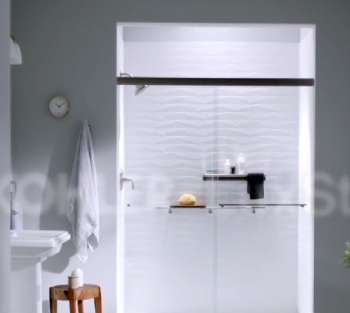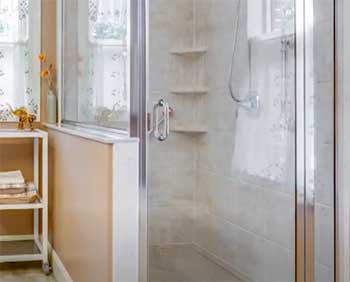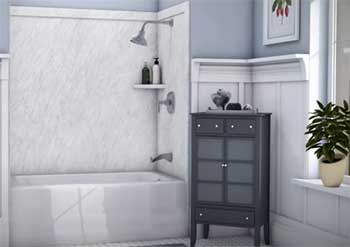One of the primary considerations when renovating your bathroom is the type of shower to install. The market offers numerous materials, each with its unique attributes and aesthetic appeal. Two of the most popular options are FlexStone and acrylic showers.
This article will dive deep into these choices, unraveling the pros and cons, and ultimately providing an informative guide to help make your decision easier.
A Brief Comparison Table
| Factors | FlexStone Showers | Acrylic Showers |
| Material | Blend of polymer resins, natural minerals, and pigments | Sheets of acrylic reinforced with fiberglass |
| Durability | Highly durable, resistant to impact, chipping, and staining | Durable, but can be prone to scratches and cracks |
| Maintenance | Low maintenance, but harsh cleaners can dull the finish | Easy to maintain, but prolonged exposure to sunlight or harsh cleaners can cause discoloration |
| Aesthetics | Luxurious stone-like appearance, available in various colors and patterns | Sleek, glossy finish, available in numerous colors and styles |
| Cost | More expensive due to high-quality materials and aesthetic appeal | More cost-effective, a popular choice for budget renovations |
| Installation | Typically requires professional installation | Easier to install, possible DIY |
FlexStone Showers: The New Kid on the Block
FlexStone showers are a novel entry into the market, quickly gaining popularity for their solid surface and stone-like appearance.
FlexStone is a composite material made from a mixture of natural crushed stone, quartz or marble blended with polyester resins and coloring pigments. It combines the look and feel of real stone with the flexibility of acrylic.
FlexStone shower walls are created using lightweight composite panels. These durable panels can be cut and installed over existing walls. The stone patterns and colors run throughout the panel thickness so edges remain visually appealing.
For shower bases, FlexStone offers preformed trays similar to acrylic. But instead of plastic, they are constructed from FlexStone composite for a stone-like finish.
Some benefits of FlexStone for shower applications include:

- Realistic natural stone look – Mimics stone visuals better than acrylic or engineered quartz. Patterns, grains and colors resemble real granite, slate, etc.
- Harder and more durable than acrylic – Resists scratches, dents and damage from impacts. Won’t crack or chip easily.
- Waterproof and low-maintenance – Sealed material resists moisture and won’t support mold growth. Easy soap and water cleaning.
- Good slip resistance – Texture provides traction when wet. Isn’t as glossy or slippery as acrylic.
- Easy DIY installation – Wall panels can be applied over existing surfaces. Preformed bases just need leveling and securing.
- Cost-effective – More affordable than natural stone tile but pricier than basic acrylic. Depends on thickness and design.
The main drawback is that FlexStone requires more installation work than acrylic. But the natural stone look and added durability make it a popular choice for shower walls and bases.
Pros of FlexStone Showers
FlexStone shines when it comes to durability. This material is resistant to impact, chipping, and staining.
A correctly installed FlexStone shower can last for decades, answering the query, “How long does FlexStone last?” As a bonus, its non-porous nature makes it resistant to mold and mildew.
Aesthetically, FlexStone provides a luxurious look akin to natural stone, available in multiple colors and patterns. Additionally, FlexStone’s adaptability allows for easy customization according to your bathroom’s dimensions and style.
Cons of FlexStone Showers
On the downside, FlexStone is more expensive than most other shower materials. Also, it requires professional installation, adding to its overall cost.
Plus, though resistant to most stains, harsh cleaners can dull its finish over time.
Acrylic Showers: The Tried and True Option
Acrylic sheets consist of acrylic resins, minerals, and pigments. When heated, acrylic becomes soft and pliable so it can be molded into seamless shower walls and bases.
For shower construction, acrylic sheets are heated and vacuum-formed over a mold to create one-piece units. Some key traits of acrylic showers:

- Glossy appearance – Acrylic has a plastic-like sheen, though some are formulated with mineral particles for a textured look.
- Easy installation – Preformed acrylic pieces require less labor to install vs. tile or stone panels.
- Affordable cost – Low material and installation costs make acrylic very budget-friendly.
- Good water resistance – Acrylic resists moisture well and inhibits soap scum buildup.
- Prone to scratching – Softer surface is easy to damage from impacts and abrasion over time.
- Can feel slippery – The glossy surface feels slippery when wet. Textured patterns help improve traction.
- Not as durable as stone – Flexible material is vulnerable to cracks and punctures from objects hitting it.
- Supports mildew growth – Acrylic is not antimicrobial like natural stone. Needs consistent cleaning to prevent mildew.
With proper care, acrylic showers can last a long time and provide an economical bathing solution. The tradeoffs are the plastic appearance and softer surface.
Pros of Acrylic Showers
Acrylic showers have a reputation for their resilience and easy maintenance.
They are also more cost-effective, making them a popular choice for budget-conscious renovators.
The non-porous surface of acrylic is resistant to mold, mildew, and most stains, making cleaning a breeze.
In terms of aesthetics, acrylic showers have a glossy finish, lending a sleek, modern look to your bathroom.
They are also available in numerous colors, sizes, and styles, providing significant flexibility in design.
Cons of Acrylic Showers
The main downside of acrylic showers is that they can scratch or crack under heavy impact. Though typically durable, they may not have the same longevity as FlexStone showers.
They can also discolor over time with exposure to direct sunlight or harsh chemicals.
Key Differences Between FlexStone and Acrylic Showers
- Material Composition

One of the fundamental differences between FlexStone and acrylic showers is the composition of the materials used. FlexStone showers use a blend of polymer resins, natural minerals, and pigments, providing a realistic and durable stone-like surface.
On the other hand, acrylic showers are made from sheets of acrylic reinforced with fiberglass, offering a sleek, modern look.
- Durability and Maintenance
FlexStone showers are renowned for their durability. They are resistant to impact, chipping, staining, and even mildew. This makes them long-lasting and low-maintenance. However, you should avoid using harsh cleaning agents, as they may dull the finish over time.
Acrylic showers are also sturdy and easy to maintain. However, they can be prone to scratches and cracks if exposed to heavy impact. And while they are resistant to most stains, prolonged exposure to sunlight or harsh cleaning products can lead to discoloration.
- Aesthetic Appeal
The aesthetic difference between FlexStone and acrylic showers is significant. FlexStone offers a premium, luxurious look that resembles natural stone. You can choose from a variety of colors and patterns to match your bathroom decor.
Acrylic showers, in contrast, have a glossy finish that imparts a contemporary, clean look. They’re available in a wide array of colors and styles, which gives you flexibility in design.
- Cost and Installation
In terms of cost, FlexStone showers tend to be more expensive than acrylic showers. This is due to the high-quality materials used and the stone-like aesthetic appeal.
Additionally, FlexStone showers typically require professional installation, adding to the overall cost.

Acrylic showers are more budget-friendly, making them a popular choice for homeowners seeking a cost-effective solution. They are also easier to install, which can further reduce the overall cost if you’re comfortable with a DIY approach.
The choice between FlexStone and acrylic showers comes down to your specific needs and preferences. Both options have their unique advantages, so weigh these factors carefully to make the best choice for your bathroom renovation.
In the battle of “FlexStone vs. acrylic shower,” both materials present significant advantages. FlexStone offers a premium, luxurious look and exceptional durability. In contrast, acrylic provides a cost-effective solution, with an appealing glossy finish and easy maintenance.
To answer the question, “What is the best material for a stand up shower?” it depends on your personal preferences, budget, and bathroom style.
Frequently Asked Questions (FAQ)
The best material for a stand-up shower depends on your budget, aesthetic preferences, and maintenance willingness. FlexStone offers a luxurious stone-like appearance and excellent durability but comes at a higher cost. On the other hand, acrylic showers are cost-effective, easy to maintain, and come in a variety of colors and styles.
With proper installation and care, a FlexStone shower can last for decades. Its durability is one of its major selling points, making it a worthy investment for many homeowners.
Acrylic showers tend to be more durable and resistant to staining compared to fiberglass showers. They’re also easier to maintain and come in more design options. However, fiberglass showers may be more budget-friendly.
FlexStone is composed of a blend of polymer resins, natural minerals, and pigments. This unique combination creates a durable and realistic stone pattern surface that is resistant to impact, chipping, and staining.
LuxStone is a premium brand of FlexStone panels made with higher-quality resins and stone materials. It provides enhanced realism, durability, and stain resistance versus standard FlexStone. Overall, LuxStone is better than acrylic for shower walls if you want the look and feel of real stone.
For the most realistic stone finish, materials like FlexStone and LuxStone are considered the best. They mimic natural stone better than acrylic in terms of look, feel, and durability. Tile is also excellent but requires more installation expertise.
Wrapping Up
In conclusion, the choice between a FlexStone and an acrylic shower will primarily depend on your budget, personal style, and durability needs.
Both options have their merits, so understanding their pros and cons is crucial for making an informed decision that will add value and comfort to your home.

